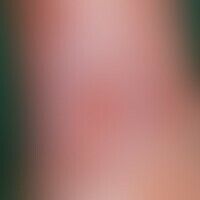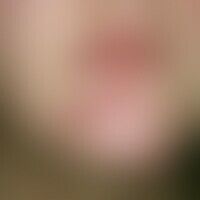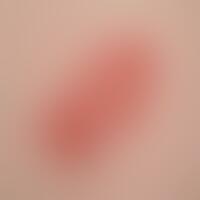Image diagnoses for "red"
877 results with 4458 images
Results forred

Venous leg ulcer I83.0
Ulcus cruris venosum. deep, punched out ulcer on the lower leg in CVI. the edges are macerated whitish in places. there is a film of zinc paste in the surrounding area.

Cholesterol embolism T88.8
Cholesterol embolism: Patient with recurrent, suddenly occurring, very painful, therapy-resistant ulcers; moderately pronounced livedo image.

Mallorca acne L70.8
Acne, Majorca acne, detail enlargement: Disseminated standing, 1-3 mm large, reddened, acne-like papules on the back of a 36-year-old patient.

Polymorphic light eruption L56.4
Light dermatosis, polymorphic: multiple, itchy, highly red urticarial papules, sometimes confluent to large plaques.

Urticaria (overview) L50.8
Urticaria cholinergic: small wheals in the area of the trunk after physical exertion.

Acuminate condyloma A63.0
Condylomata acuminata in an infant; perianal, scrotal and inguinal small, pointy-headed, reddish, soft, rough papules.

Sweet syndrome L98.2

Lupus erythematodes chronicus discoides L93.0
Lupus erythematodes chronicus discoides. sharply defined, reddish, disc-shaped, partly scaly plaques with follicular hyperkeratosis and central atrophy; partly hypopigmentation or hyperpigmentation. chronic course. photosensitivity.

Palmar and plantar filides A51.3
Palmar and plantar filids: disseminated, reddish-brown, scaly papules on palms and soles; no itching; generalized lymphadenopathy.

Psoriasis vulgaris chronic active plaque type L40.0
Psoriasis vulgaris chronic active plaque type: in addition to long-term psoriatic plaques, disseminated, small psoriatic lesions as a sign of "relapse activity".

Lichen sclerosus (overview) L90.4
Lichen sclerosus et atrophicus. extensive infestation. extensive fresh and older bleeding.

Carcinoma of the skin (overview) C44.L
Cutaneous carcinoma: a flat growing, circinally limited, red plaque, without any symptoms Diagnosis: Bowen's disease












